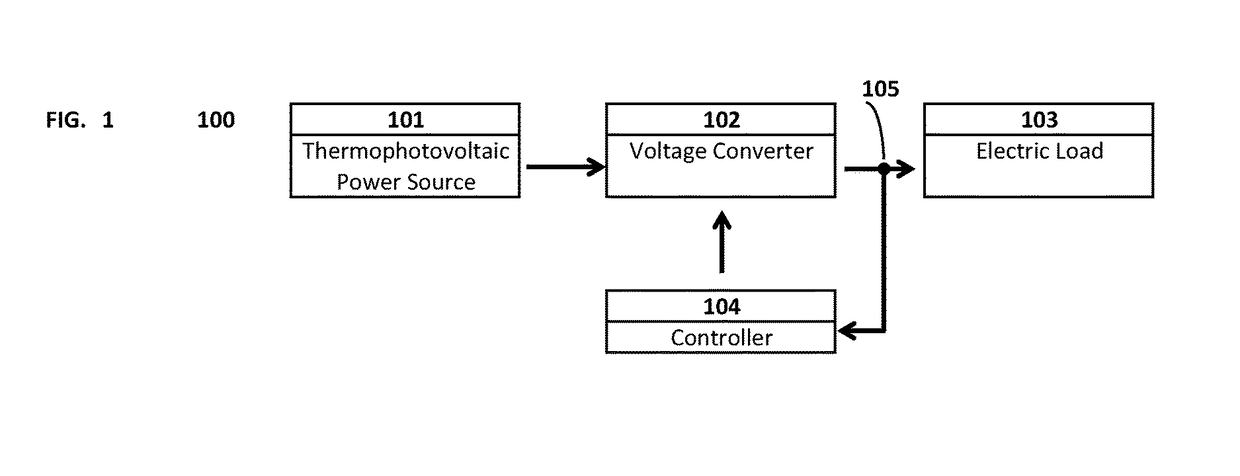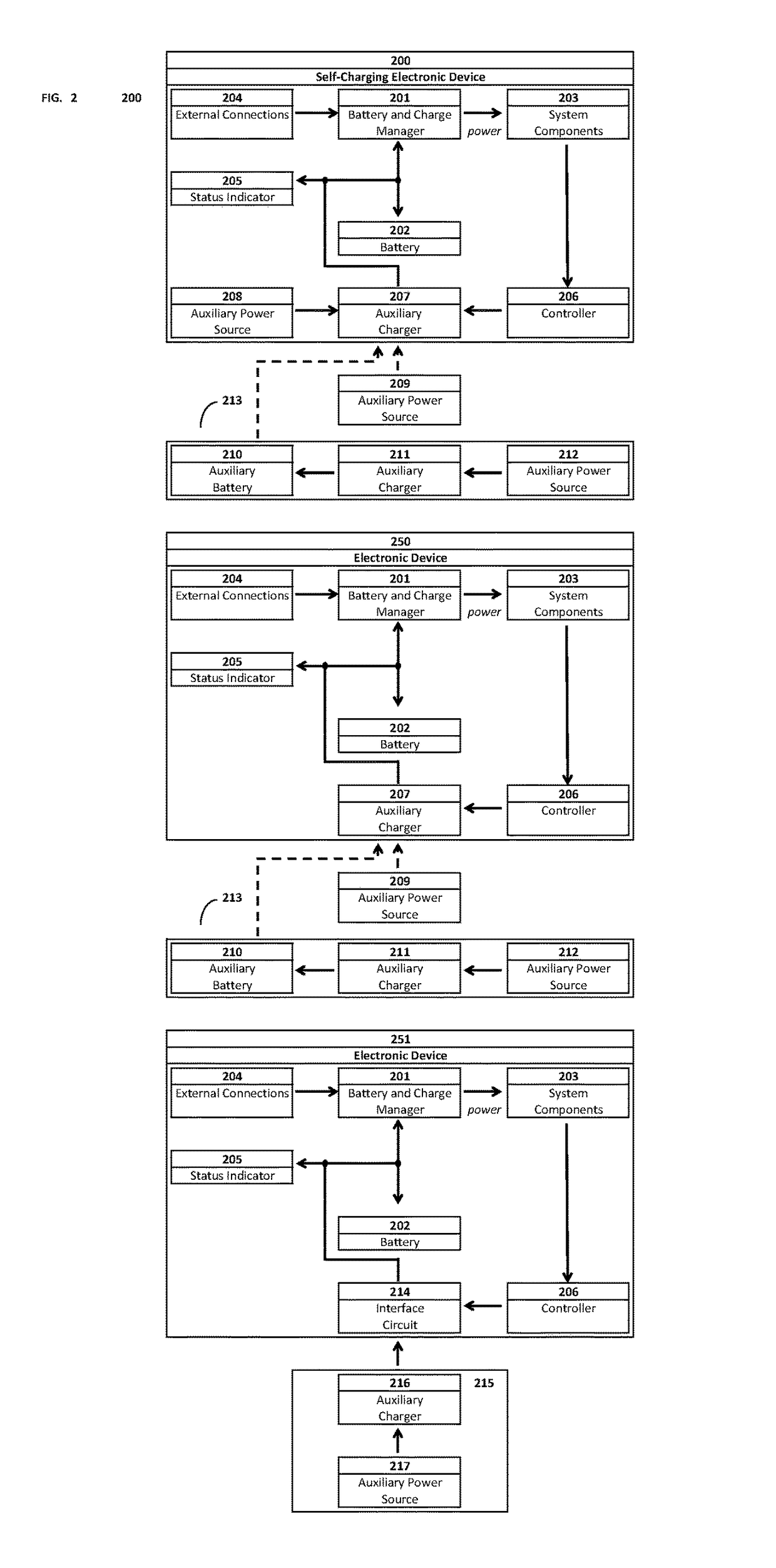[0017]Known thermophotovoltaic systems are fundamentally limited by inadequate separation and transport capabilities. Such systems attempt to avoid recombination and photocorrosion by harvesting a relatively narrow range of IR radiation (typically NIR) emissions from an intense (high temperature) proximate source of radiation. It is common for such systems to first use the source to heat an emitter (e.g., a tungsten plate) with emissivity characteristics which in turn limits the incoming flux to wavelengths that the cell can more readily convert (e.g., NIR radiation using a GaSb cell with a 0.75 eV band gap). The spectral radiancy can be further restricted by placing a pass band filter between the emitter and the cell to reflect all but the desired wavelengths away from the cell. Despite these protections, the radiation incident upon the cell that is not converted to electricity heats the device, which reduces the charge carrier mobility and photoconversion efficiency (PCE) of the semiconductor. As a result, known thermophotovoltaic cells are limited to NIR systems designed to operate from about 1,300 to 2,000 K.
[0018]In the present invention, a microprocessor of a self-charging electronic device can be contiguous to or in communication with a thermophotovoltaic cell which can also optionally also be contiguous to or in communication with an exterior surface of the self-charging electronic device; and which thermophotovoltaic cell is at least in part comprised of structures which orthogonalize absorption and charge separation and that facilitate rapid charge transport to underlying electrical contacts, such that separation occurs more rapidly over comparatively much smaller distances (i.e., on the order of nanometers versus microns), thereby reducing the sort of recombination penalties and associated thermalization losses that plague known devices for converting the energy contained in photons into electrical energy. In one embodiment, the thermophotovoltaic cell is at least in part comprised of vertically-oriented, one-dimensional, monocrystalline, n-type anatase nanowires in communication with a transparent conductive substrate, and which are intercalated with a consortia of p-type quantum dots tuned for absorption of infrared and other radiation. In this architecture, the compositions and sizes of the quantum dots and nanowires can enable broad spectrum absorption and charge production, including by multiple exciton generation; and, the composition, structure, shape and orientation of the nanowires enable rapid charge separation and transport, thereby minimizing recombination and the associated thermalization and other losses. Thermal energy absorbed by this architecture can result in infrared emissions within the high surface area basal plane of the nanowires (e.g., from nanowire to nanowire) for absorption and further charge production by the thermophotovoltaic cell. In this manner, thermalization upon exposure to radiation can be reduced in comparison to known devices and, significantly, thermal energy from the microprocessor, thermophotovoltaic cell and / or other components of the self-charging electronic device, as well as from one or more sources external to the self-charging electronic device, becomes a valuable new source of electricity to power the self-charging electronic device. Heat is not merely dissipated and lost as a form of waste in such uses, but rather recovered as it is converted to additional electrical energy.
[0021]In some cases, the amount of voltage and / or current generated by the thermophotovoltaic cells can not be enough to power the self-charging electronic device. Thus, in some embodiments, boost circuitry powered by a battery and / or the thermophotovoltaic cells can regulate the power generated by the thermophotovoltaic cells. The boosted power can then be used to power other components of the self-charging electronic device. In addition, the self-charging electronic device can include circuitry, such as bootstrap circuitry which can monitor the state of the battery. If the battery is not drained (e.g., battery is generating energy above a predetermined minimum threshold), the circuitry can connect the thermophotovoltaic cells in a series / parallel configuration, which can allow the thermophotovoltaic cells to generate a constant preset voltage as long as a subset of the thermophotovoltaic cells is operating. This configuration can provide protection by allowing the thermophotovoltaic cells to continue powering the self-charging electronic device even if the thermophotovoltaic cells are partially obstructed. In the series / parallel configuration, a subset of the thermophotovoltaic cells, for example pairs of thermophotovoltaic cells, can be connected in a parallel configuration to form parallel groups. Each of the parallel groups can then be connected in series.
[0022]In the event that the battery is drained (e.g., battery is generating energy below a predetermined minimum threshold), the boost circuitry can not be powered by the battery. In such circumstances, the thermophotovoltaic cells can be connected in a series configuration that facilitates the generation of a startup voltage sufficient to power the self-charging electronic device. The startup voltage can be configured to be higher than the voltage generated by the thermophotovoltaic cells in the series / parallel configuration. In some cases, the thermophotovoltaic cells can also be used to directly power the boost circuitry when the thermophotovoltaic cells are connected in the series configuration. As a result, the boost circuitry can continue to regulate the power generated by the thermophotovoltaic cells even when the battery is drained.
[0026]In one embodiment, a subset of the thermophotovoltaic cells can be configured to generate a constant preset voltage for powering the self-charging electronic device using a matrix of switches. In some embodiments, the self-charging electronic device circuitry can automatically reconfigure the flow of electricity generated by the thermophotovoltaic cells based on such factors as the operational state of the self-charging electronic device, the availability and amount of thermal energy, and the availability of multiple power sources.
[0027]The self-charging electronic devices of the present invention convert radiation emitted at least in part from one or more sources of thermal energy that are not the sun into additional charge, which sources can further include one or more components of the electronic devices themselves. Such capabilities allow the self-charging electronic devices to access multiple sources of consistent and stable power, and to realize improved component performance and battery life. The capability of absorbing and utilizing thermal energy improves the electronic device's heat tolerance, and provides increased options to reduce cost and to enhance the design, construction methods, component and feature inclusion, and performance of self-charging electronic devices.
 Login to View More
Login to View More 


